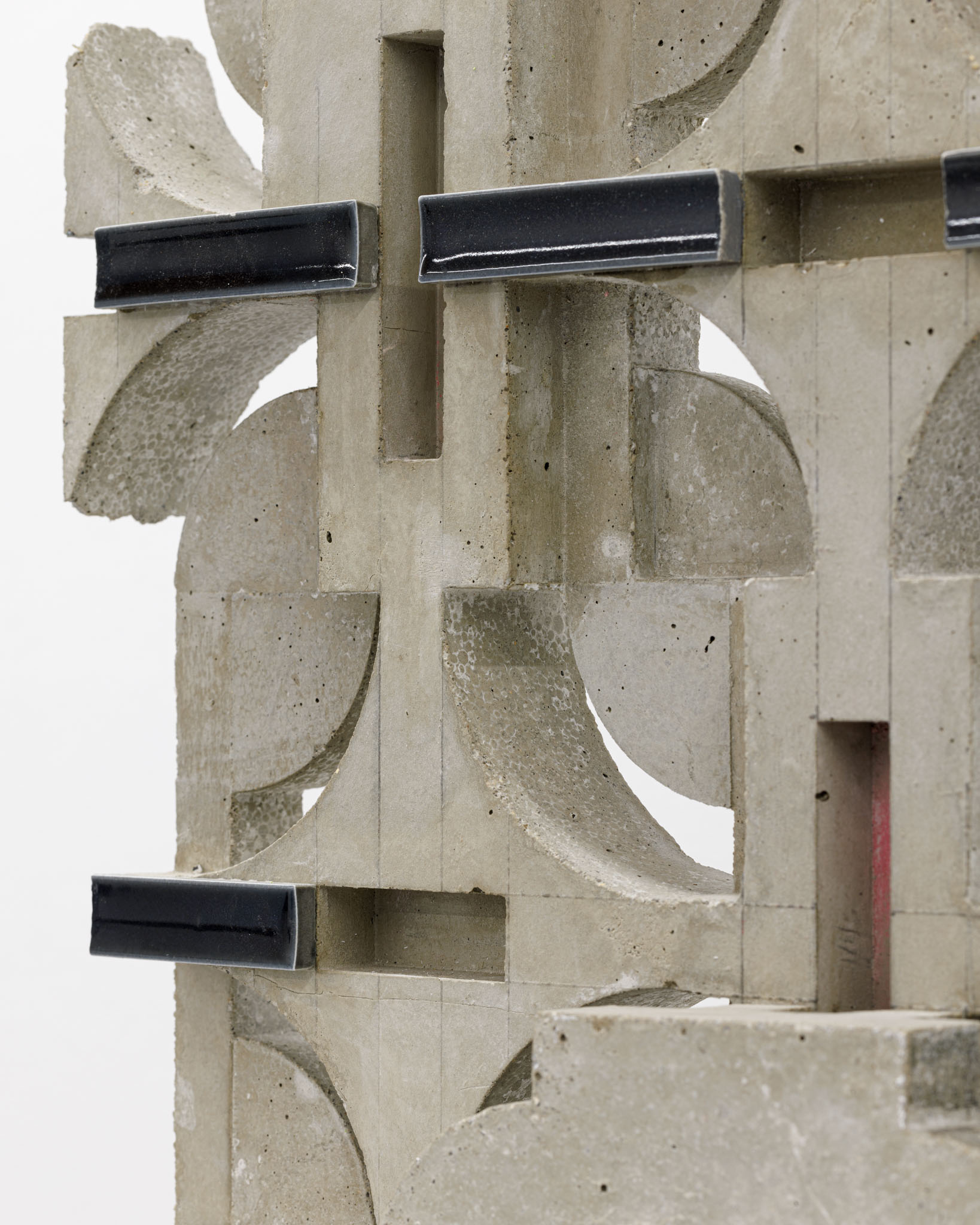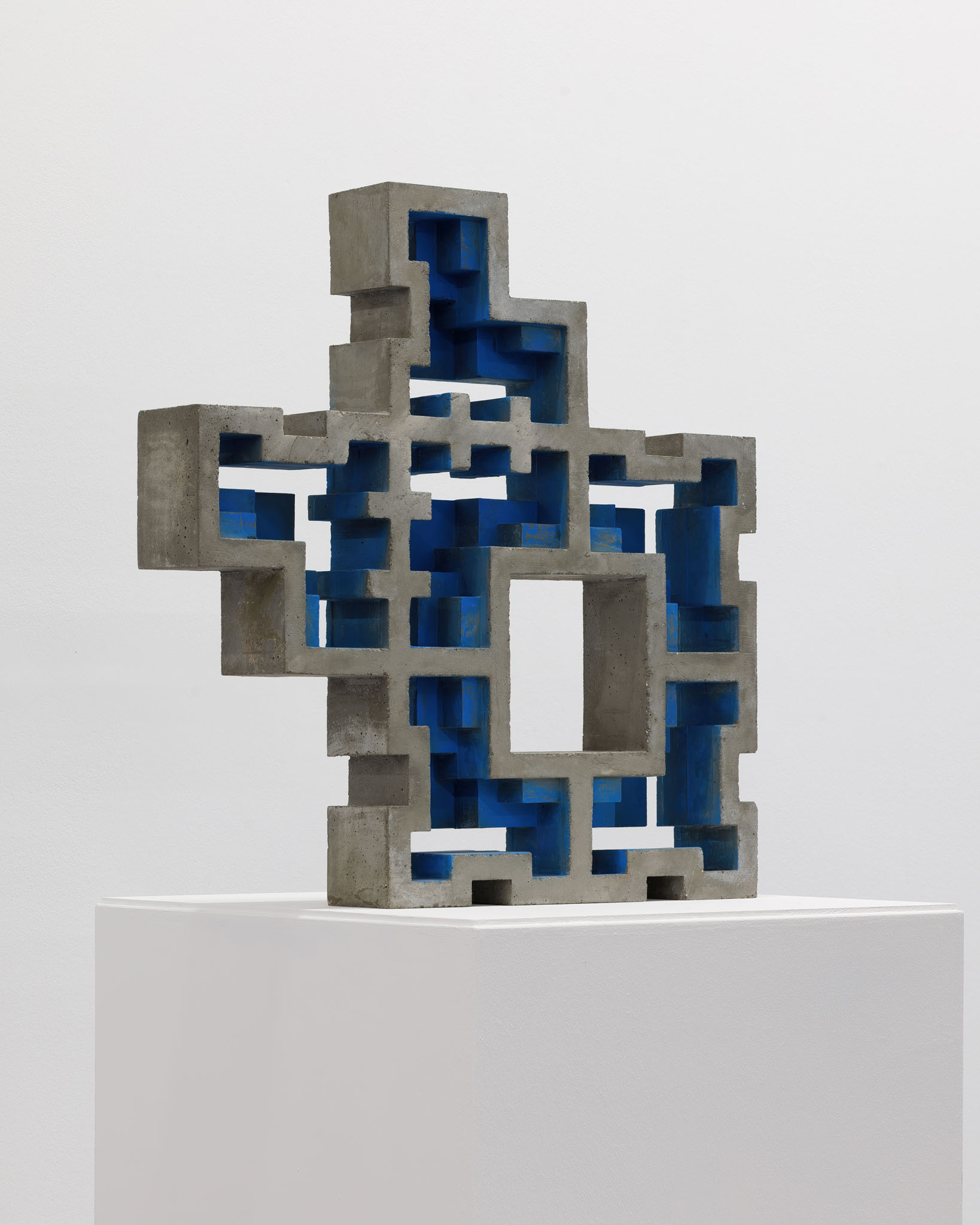Susanne Piotter –
Alternate Angles
Alternate Angles























In "Alternate Angles," her first solo exhibition at "B-Part Exhibition," Berlin-based artist Susanne Piotter (*1969) takes a varied look at the formal world of post-war concrete brutalism - a world that is familiar and yet seems far away. These are works with cubatures without a common denominator, fragile-seeming and yet stable formations with the most diverse outlines, which catapult the viewer instantly into a past future. With her small-format sculptures and structures made of concrete, the artist shows here that the architectural style that has long since fallen into disuse is also worth a second and third artistic look.
For "Alternate Angles," the artist has selected works from three related series: "Artifacts," "Repetitive Structures," and recent works that focus on the motif of the tube. Each cast in white cement tinted with pigments and colored by her in signal colors where details and elements of her works are to be emphasized, her "Artefacts" in particular appear as models of architectures, such as those (familiar) from science fiction films of the 1970s.
The impression is not deceptive, for Piotter, who studied media design and stage design, among other things, takes up dimensions of the nostalgic in the production process of her small sculptures - whereby the experiment is in the foreground, for the works find their form exclusively during the elaboration of the negative form, they are therefore not preconceived. However, Piotter's "artifacts" are only supposed to be models; the artist understands the sculptures, which are equipped with angular and round, flat and voluminous forms, as sculptures in their own right, which do not refer to a larger "actual". Accordingly, their almost handy "artifacts" also know no spatial orientation and could be placed over the duration of an exhibition again and again, turned differently, variable.
Her "Repetitive Structures" are different: as rather flat concrete works in which repetition appears both as ornament and as a constructive condition, these works play with the idea of decoration and plastic structure, which is also not uncommon in Brutalism. They are thus more likely to be located on walls and floors than on pedestals, and are less autonomous than a section of a conceivably even larger structure.
---
1 It was probably not only exhibitions with international appeal such as "SOS Brutalism" (2017, Deutsches Architekturmuseum) that recently brought new attention to the topic of Brutalism. Rather, it is also daily encounters in the urban space and the current struggle for reuse and new uses that make this past architectural epoch pose questions to the present - especially in Berlin, where buildings and structures such as the Mäusebunker, the Bierpinsel, or the two "San Gimignano Lichtenberg" towers used by Brandlhuber+ are currently receiving increased attention.
Piotter's "tube" works also reveal themselves as cutouts. These likewise flat, cast concrete slabs, through which cut-up tubular structures seem to make their orderly way, are reminiscent of systems of communication, supply, and infrastructure (pneumatic post, Centre Pompidou, subway), but also, in art historical terms, of similar forms in the work of Eduardo Paolozzi. As with Susanne Piotter's other series, the same applies to this exhibition: the perspective on her works changes depending on the attribution, because just as the tube works do not refer to any "actual greater", are not models but "open" works, it is left to the imagination to determine what else they could be, are.
---
The B-Part Exhibition space accompanies the future development of the Urbane Mitte Am Gleisdreieck with artistic autonomy and thus at the same time enters into a dialogue with the overarching themes of the overall project - forms of New Work, Co-working, Culture and Sport - and creates synergies between artistic, cultural and social approaches. The artistic director of the B-Part Exhibition is Rüdiger Lange (loop - raum für aktuelle kunst).
For "Alternate Angles," the artist has selected works from three related series: "Artifacts," "Repetitive Structures," and recent works that focus on the motif of the tube. Each cast in white cement tinted with pigments and colored by her in signal colors where details and elements of her works are to be emphasized, her "Artefacts" in particular appear as models of architectures, such as those (familiar) from science fiction films of the 1970s.
The impression is not deceptive, for Piotter, who studied media design and stage design, among other things, takes up dimensions of the nostalgic in the production process of her small sculptures - whereby the experiment is in the foreground, for the works find their form exclusively during the elaboration of the negative form, they are therefore not preconceived. However, Piotter's "artifacts" are only supposed to be models; the artist understands the sculptures, which are equipped with angular and round, flat and voluminous forms, as sculptures in their own right, which do not refer to a larger "actual". Accordingly, their almost handy "artifacts" also know no spatial orientation and could be placed over the duration of an exhibition again and again, turned differently, variable.
Her "Repetitive Structures" are different: as rather flat concrete works in which repetition appears both as ornament and as a constructive condition, these works play with the idea of decoration and plastic structure, which is also not uncommon in Brutalism. They are thus more likely to be located on walls and floors than on pedestals, and are less autonomous than a section of a conceivably even larger structure.
---
1 It was probably not only exhibitions with international appeal such as "SOS Brutalism" (2017, Deutsches Architekturmuseum) that recently brought new attention to the topic of Brutalism. Rather, it is also daily encounters in the urban space and the current struggle for reuse and new uses that make this past architectural epoch pose questions to the present - especially in Berlin, where buildings and structures such as the Mäusebunker, the Bierpinsel, or the two "San Gimignano Lichtenberg" towers used by Brandlhuber+ are currently receiving increased attention.
Piotter's "tube" works also reveal themselves as cutouts. These likewise flat, cast concrete slabs, through which cut-up tubular structures seem to make their orderly way, are reminiscent of systems of communication, supply, and infrastructure (pneumatic post, Centre Pompidou, subway), but also, in art historical terms, of similar forms in the work of Eduardo Paolozzi. As with Susanne Piotter's other series, the same applies to this exhibition: the perspective on her works changes depending on the attribution, because just as the tube works do not refer to any "actual greater", are not models but "open" works, it is left to the imagination to determine what else they could be, are.
---
The B-Part Exhibition space accompanies the future development of the Urbane Mitte Am Gleisdreieck with artistic autonomy and thus at the same time enters into a dialogue with the overarching themes of the overall project - forms of New Work, Co-working, Culture and Sport - and creates synergies between artistic, cultural and social approaches. The artistic director of the B-Part Exhibition is Rüdiger Lange (loop - raum für aktuelle kunst).
